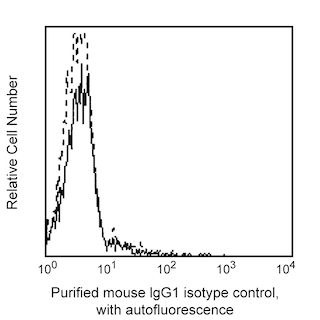-
Your selected country is
Middle East / Africa
- Change country/language
Old Browser
This page has been recently translated and is available in French now.
Looks like you're visiting us from {countryName}.
Would you like to stay on the current country site or be switched to your country?




Flow cytometric analysis of CD26 expression on human peripheral lymphocytes. Human whole blood was stained with either Purified Mouse Anti-Human CD26 (Cat. No. 555435; solid line histogram) or Purified Mouse IgG1, κ Isotype Control (Cat. No. 555746; dashed line histogram), followed by FITC Goat Anti-Mouse IgG/IgM (Cat. No. 555988). Erythrocytes were lysed with BD Pharm Lyse™ Lysing Buffer (Cat. No. 555899). Fluorescent histograms were derived from gated events with the forward and side light-scattering characteristic of viable lymphocytes. Flow cytometry was performed on a BD FACScan™ system.


BD Pharmingen™ Purified Mouse Anti-Human CD26

Regulatory Status Legend
Any use of products other than the permitted use without the express written authorization of Becton, Dickinson and Company is strictly prohibited.
Preparation And Storage
Product Notices
- Caution: Sodium azide yields highly toxic hydrazoic acid under acidic conditions. Dilute azide compounds in running water before discarding to avoid accumulation of potentially explosive deposits in plumbing.
- Sodium azide is a reversible inhibitor of oxidative metabolism; therefore, antibody preparations containing this preservative agent must not be used in cell cultures nor injected into animals. Sodium azide may be removed by washing stained cells or plate-bound antibody or dialyzing soluble antibody in sodium azide-free buffer. Since endotoxin may also affect the results of functional studies, we recommend the NA/LE (No Azide/Low Endotoxin) antibody format, if available, for in vitro and in vivo use.
- Please refer to www.bdbiosciences.com/us/s/resources for technical protocols.
- Please refer to http://regdocs.bd.com to access safety data sheets (SDS).
Companion Products





.png?imwidth=320)
The M-A261 monoclonal antibody specifically binds to CD26. CD26 is also known as dipeptidyl peptidase IV (DPPIV/DPP IV, DPP4) or adenosine deaminase binding protein (ADABP). CD26 is a 110 kDa type II transmembrane glycoprotein. CD26 is expressed by T lymphocytes and increases upon activation. It is also expressed by B cells, NK cells, and macrophages. CD26 is an ectoenzyme which plays an integral role in T-cell proliferation and may interact with extracellular matrix proteins such as fibronectin or collagen.
Tissue culture supernatant is purified by either protein A/G or affinity purification methods. Both methods yield antibody in solution that is free of most other soluble proteins, lipids, etc. This format provides pure antibody that is suitable for a number of downstream applications including: secondary labeling for flow cytometry or microscopy, ELISA, Western blot, etc.
The CD26 antigen can serve as a receptor for the coronavirus, MERS-CoV.
Development References (6)
-
Dang NH, Torimoto Y, Schlossman SF, Morimoto C. Human CD4 helper T cell activation: functional involvement of two distinct collagen receptors, 1F7 and VLA integrin family. J Exp Med. 1990; 172(2):649-652. (Biology). View Reference
-
Kameoka J, Tanaka T, Nojima Y, Schlossman SF, Morimoto C. Direct association of adenosine deaminase with a T cell activation antigen, CD26. Science. 1993; 261(5120):466-469. (Biology). View Reference
-
Lu G, Hu Y, Wang Q, et al. Molecular basis of binding between novel human coronavirus MERS-CoV and its receptor CD26.. Nature. 2013; 500(7461):227-31. (Biology). View Reference
-
Schlossman SF. Stuart F. Schlossman .. et al., ed. Leucocyte typing V : white cell differentiation antigens : proceedings of the fifth international workshop and conference held in Boston, USA, 3-7 November, 1993. Oxford: Oxford University Press; 1995.
-
Scholz W, Mentlein R, Heymann E, Feller AC, Ulmer AJ, Flad HD. Interleukin 2 production by human T lymphocytes identified by antibodies to dipeptidyl peptidase IV. Cell Immunol. 1985; 93(1):199-211. (Biology). View Reference
-
Stein H, Schwarting R, Niedobitek G. Cluster report: CD26. In: Knapp W. W. Knapp .. et al., ed. Leucocyte typing IV : white cell differentiation antigens. Oxford New York: Oxford University Press; 1989:412.
Please refer to Support Documents for Quality Certificates
Global - Refer to manufacturer's instructions for use and related User Manuals and Technical data sheets before using this products as described
Comparisons, where applicable, are made against older BD Technology, manual methods or are general performance claims. Comparisons are not made against non-BD technologies, unless otherwise noted.
For Research Use Only. Not for use in diagnostic or therapeutic procedures.
Report a Site Issue
This form is intended to help us improve our website experience. For other support, please visit our Contact Us page.